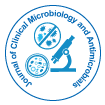
Journal of Clinical Microbiology and Antimicrobials
Open Access
+44-77-2385-9429

+44-77-2385-9429
Perspective - (2022)Volume 6, Issue 4
The common cold is also known as nasopharyngitis. A runny nose, sneezing, and coughing are some of the signs of a minor infection of the nose and throat. Viruses are the cause of nasopharyngitis. There are currently no antiviral drugs that can combat them. Antibiotics will not treat a viral illness; therefore doctors will only prescribe them if a patient has a bacterial infection-related problem. Cold medicine sold over the counter (OTC) may provide brief relief from symptoms, but it does not lessen the duration of the infection. Doctors typically encourage people who have a cold to relax, drink plenty of fluids, and seek medical help if their symptoms worsen.
The common cold is also known as nasopharyngitis. A runny nose, sneezing, and coughing are some of the signs of a minor infection of the nose and throat.
Viruses are the cause of nasopharyngitis. There are currently no antiviral drugs that can combat them. Antibiotics will not treat a viral illness; therefore doctors will only prescribe them if a patient has a bacterial infection-related problem. Cold medicine sold over the counter (OTC) may provide brief relief from symptoms, but it does not lessen the duration of the infection. Doctors typically encourage people who have a cold to relax, drink plenty of fluids, and seek medical help if their symptoms worsen.
The inflammation of the nasal passages and the pharynx, or throat, is known as nasopharyngitis. The common cold is sometimes known as this. Adults, on average, get two to four colds every year, most often during the winter months, according to study. At school or daycare, children are likely to catch six to ten colds every year. The condition is normally innocuous and resolves without causing any major consequences. In most cases, it takes 7–10 days for people to fully recover [1].
Nasopharyngitis can be caused by more than 200 viruses, but the rhinovirus is the most frequent, accounting for 10–40 percent of colds. The illness is extremely contagious. People can contract it by inhaling or touching droplets from a person who is sick with a cold.
Symptoms usually appear 1–3 days after a cold virus enters the body. Symptoms to look out for include:
Sneezing
A stuffy or runny nose
Coughing with a sore throat
Individuals may also encounter the following: Fever, weakness, and joint discomfort are all symptoms of a moderate fever. While a cold might be mistaken for the flu, the flu has more severe symptoms. A cold also takes time to develop, however the flu comes on abruptly, with a high temperature, chills, and body pains.
A cold can be diagnosed without the use of any particular testing by healthcare professionals. Because people are so acquainted with the symptoms, they rarely seek medical help. When they do, a doctor merely needs to peek into their throat and ask about their symptoms to determine whether they have a cold [2].
A nose or throat swab may be ordered by doctors when they fear someone has the flu or a more serious ailment.
If you have nasopharyngitis, you should rest and drink plenty of water. People who smoke should quit or cut back until they feel better, according to the American Lung Association (ALA). Individuals should also avoid secondhand smoke, particularly throughout the course of the sickness, since it can irritate the throat and the rest of the airway further.
There are no drugs that can combat the viruses that cause colds or reduce the length of time that they last.
Antibiotics are only efficient against bacterial infections, thus they are ineffective against viral infections like colds. Doctors may, however, prescribe them for bacterial problems associated with nasopharyngitis [3]. Some natural remedy makers say that their products can help you combat a cold, but scientific evidence contradicts these claims. Furthermore, certain natural products may have negative side effects. Some examples of such medicines are:
Echinacea, for example, is high in vitamin C, zinc, and garlic.
The CDC has provided the following advice to assist individuals protect themselves and others from catching a cold. Washing hands often with soap and water for 20 seconds, staying away from individuals who are sick, and avoiding touching the mouth, eyes, and nose with unclean hands are all ways to lower the risk of developing a cold.
Staying at home after being ill, moving away from people before coughing or sneezing, and avoiding close contact with others, such as hugging or shaking hands, can all help to reduce the risk of spreading a cold to others. sneezing or coughing into a tissue and then throwing it away after sneezing or coughing washing hands after sneezing or coughing [4].
Citation: Math T (2022) Definition, Causes, and Symptoms of Nasopharyngitis. J Clin Microbiol Antimicrob 6:143.
Received: 01-Dec-2022, Manuscript No. JCMA-22-17953; Editor assigned: 07-Dec-2022, Pre QC No. JCMA-22-17953 (PQ);; Reviewed: 21-Dec-2022, QC No. JCMA-22-17953; Revised: 28-Dec-2022, Manuscript No. JCMA-22-17953(R);; Published: 04-Jan-2023 , DOI: 10.35248/jcma.22.6.143
Copyright: © 2022 Math T. This is an open-access article distributed under the terms of the Creative Commons Attribution License, which permits unrestricted use, distribution, and reproduction in any medium, provided the original author and source are credited.